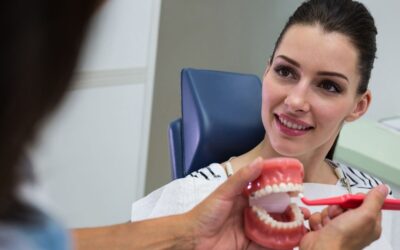A cut on your gums may seem minor at first, but it can be a source of discomfort and concern if not treated properly. The gums are an essential part of your oral health, helping to protect the underlying teeth and tissues. While a small gum cut is typically not a cause for alarm, understanding what it looks like and how to handle it can prevent complications. Whether caused by an accidental injury, poor dental hygiene, or dental procedures, a gum cut can result in pain, swelling, and bleeding.
In this article, we will explore what a gum cut looks like, its potential causes, how to treat it, and when it is necessary to seek professional care. By understanding the signs and symptoms, you can better manage a gum cut and ensure proper healing. This guide will also answer some common questions about gum cuts to help you navigate this issue with confidence.
What Causes Cuts on Your Gums?
Gum cuts can occur for a variety of reasons. Understanding the underlying causes is crucial for prevention and quick treatment.
Accidental Trauma:
One of the most common reasons for gum cuts is accidental trauma. Biting into hard foods or brushing too aggressively can cause the gums to tear. Sports injuries or accidents can also lead to cuts and abrasions in the mouth.
Dental Procedures:
Dental cleanings, extractions, or other surgical procedures may inadvertently cause cuts or irritations on the gums. Although dental professionals take great care, the use of sharp instruments or the pressure applied during treatments can sometimes lead to minor gum injuries.
Poor Oral Hygiene:
If plaque and tartar build up on the gums, they can cause irritation, leading to cuts. Poor oral hygiene can also increase the risk of gum diseases, such as gingivitis, which can make the gums more prone to injury.
Infections and Diseases:
Gum diseases like gingivitis and periodontitis can cause inflammation, making the gums more vulnerable to cuts and wounds. These infections weaken the gum tissue, leaving it fragile and easy to tear.
Foreign Objects:
Sometimes, small objects or foods that get stuck in the gums can cause them to tear. For example, splinters from food or sharp objects can result in cuts that may bleed and cause discomfort.
How to Identify a Cut on Your Gums?
Recognizing a gum cut early can help you take appropriate action to avoid complications. Here’s how to identify a cut on your gums:
Visual Appearance:
- A visible tear or break in the gum tissue, which may appear as a small or large wound.
- The cut may be shallow or deep, depending on the cause and severity of the injury.
- Swelling and redness are common around the cut, especially if the injury is fresh.
Pain and Sensitivity:
- A cut on your gums may cause mild to severe pain, particularly when chewing or brushing.
- You may also notice increased sensitivity to hot, cold, or acidic foods, which can aggravate the pain.
Bleeding:
- Gum cuts often bleed when irritated by food, brushing, or general activity.
- Minor bleeding may stop after a few minutes, but if it persists, it could be a sign of a deeper or infected wound.
Bad Breath or Foul Odor:
-
-
If the cut becomes infected, it may produce a foul smell, signaling the need for prompt attention.
-
Treatment Options for Gum Cuts
If you experience a gum cut, prompt and appropriate treatment can help prevent further complications, such as infection. Here’s a detailed guide on how to treat a gum cut at home and when to seek professional help:
At-Home Care:
- Salt Water Rinse: Rinsing your mouth with warm salt water can help cleanse the area, reduce swelling, and promote healing. Mix a teaspoon of salt in a glass of warm water and rinse several times a day.
- Cold Compress: Applying a cold compress on the outside of your mouth can help reduce swelling and numb the area to alleviate pain. Hold it against the affected area for 10-15 minutes at a time.
- Avoid Irritating Foods: Spicy, hot, or acidic foods can aggravate the cut and cause additional pain. Stick to soft, bland foods while the wound heals.
- Maintain Good Oral Hygiene: Continue brushing your teeth gently, but avoid brushing the affected area directly. Use a soft-bristled toothbrush to avoid further irritation.
Over-the-Counter Medications:
Nonsteroidal anti-inflammatory drugs (NSAIDs), such as ibuprofen, can help manage pain and reduce swelling. Always follow the dosage instructions on the package.
- An antiseptic mouthwash can also help reduce the risk of infection and promote healing.
When to See a Dentist:
- Deep Cuts or Lacerations: If the cut is deep, it may require stitches or other professional treatment to heal properly.
- Persistent Bleeding: If the bleeding lasts longer than 15 minutes or is difficult to stop, seek immediate dental or medical attention.
- Infected Wounds: If the cut becomes swollen, warm to the touch, or shows signs of pus, it may be infected, and you should visit a dentist as soon as possible.
When to See a Dentist for a Gum Cut?
While many gum cuts heal naturally with home treatment, there are situations where it is important to consult a dentist:
-
Signs of Infection: If you notice signs of infection, such as pus, a foul smell, or increased pain around the affected area, it’s crucial to see a dentist. Infections can spread if not treated promptly, leading to more severe complications like abscesses or tooth loss.
-
Excessive Bleeding: If the cut continues to bleed for an extended period, it may indicate a more serious injury that requires professional care.
-
Severe or Chronic Pain: A gum cut that causes severe or long-lasting pain, despite home remedies, should be evaluated by a dentist. Pain can be a sign of an underlying issue, such as an infected or impacted tooth.
-
Difficulty Eating or Speaking: If the gum cut makes it difficult to eat, drink, or speak, it may be necessary to see a dentist for further evaluation and treatment.
Preventing Cuts on Your Gums
Preventing gum cuts is the best way to avoid the pain and inconvenience associated with them. Here are some tips to keep your gums healthy and minimize the risk of injury:
-
Use a Soft Toothbrush: A soft-bristled toothbrush is gentle on the gums and reduces the chances of cuts or abrasions. Avoid using hard-bristled brushes, as they can irritate the gums.
-
Brush Gently: Brushing your teeth too aggressively can cause your gums to bleed or cut. Use gentle strokes and avoid brushing too hard on the gumline.
-
Avoid Hard or Sharp Foods: Foods with sharp edges, such as chips, nuts, or hard candy, can cut your gums. If possible, avoid eating these foods, or be cautious while chewing them.
-
Wear a Mouthguard: If you play contact sports, wear a mouthguard to protect your gums, teeth, and other oral tissues from injury.
-
Regular Dental Checkups: Visit your dentist regularly for checkups and cleanings. Regular professional care can help detect issues early and keep your gums healthy.
FAQs
Can a gum cut heal on its own?
Yes, minor gum cuts typically heal on their own within a few days. However, deeper or infected cuts may require professional treatment.
How long does it take for a gum cut to heal?
Minor gum cuts usually heal in 3 to 5 days, but deeper cuts may take longer, especially if they become infected.
Should I avoid brushing my teeth if I have a cut on my gums?
It’s important to continue brushing your teeth gently, but avoid brushing directly on the affected area. Use a soft-bristled toothbrush and be gentle around the cut.
What can I do if my gum cut keeps bleeding?
If the bleeding persists for more than 10-15 minutes, apply gentle pressure with a clean cloth and visit a dentist for further evaluation.
Can a cut on my gums be a sign of a bigger issue?
A gum cut can sometimes indicate underlying issues like gum disease. If the cut is recurrent or doesn’t heal, it’s essential to see a dentist for evaluation.
How can I prevent gum cuts in the future?
To prevent gum cuts, brush gently with a soft toothbrush, avoid hard or sharp foods, maintain good oral hygiene, and wear a mouthguard during sports activities.
Conclusion:
A gum cut, while common, should not be ignored. Though minor cuts may heal naturally, it is important to take the necessary steps to treat and care for them to avoid complications. Whether caused by accidental trauma, poor oral hygiene, or infections, being proactive in your oral health care is essential. Understanding what a gum cut looks like, recognizing the symptoms, and knowing when to seek professional help can save you from further discomfort or damage.
By following preventive measures, such as maintaining good oral hygiene and wearing a mouthguard during sports, you can significantly reduce the risk of gum cuts. If you experience any symptoms of infection, persistent bleeding, or severe pain, always consult a dentist for proper care.



